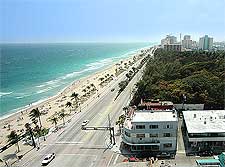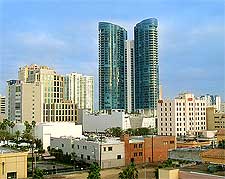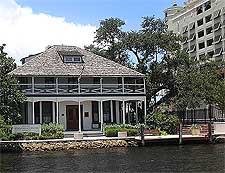Fort Lauderdale History Facts and Timeline
(Fort Lauderdale, Florida - FL, USA)

The first people to inhabit the area of New River, now modern day Fort Lauderdale, were aboriginal natives followed by Tequesta Indians. Unfortunately, with the arrival of the Spanish and British, the earliest pioneer settlers in local history, the Tequesta rapidly declined from disease and war.
By the 1830s, there were some 70 residents living in the 'New River Settlement' that was later to become known as Fort Lauderdale. However, the white residents of the settlement fled the area in 1836 after the Seminoles attacked the family of William Cooley, a governor of the region.
Post Seminole War
The Second Seminole War, which was fought between 1835 and 1842, led to the construction of the Fort Lauderdale stockade on the New River, named after the general that commanded the local war effort, Major General William Lauderdale. After the war, the area was deserted until 1893, when Vienna-born Frank Stranahan arrived to man a new ferry crossing over the New River.
Stranahan set up a trading post, which aided the development of the eventual city of Fort Lauderdale. His original house is still standing today at its same spot on the banks of the New River and offers regular tours daily. Of note, this is the oldest house in Broward County.
Despite the new crossing and trading post, development didn't really begin in Fort Lauderdale until 1896, when the Florida East Coast Railroad extended its line from West Palm Beach and through the settlement en route to
Miami. The arrival of the railway signified a major change in Fort Lauderdale history.
[

TITLE2]Early 20th Century
Fort Lauderdale became an incorporated city in 1911, but experienced its first major population and development hike at the time of the 1920s Florida land rush and real estate boom. However, the city struggled after the Miami Hurricane of 1926 and the Great Depression of 1929.
During WWII, the city was a major US military base and this post-war era saw many servicemen return here to reside. The Old Fort Lauderdale Village and Museum (History Center) provides tourists with an up-close experience of life in the city at the turn of the last century. The New River Inn of 1905 and the 1907 King-Cromartie House are just some of the city's historic buildings that are worth visiting.

1945 to Modern-Day
The population of Fort Lauderdale exploded post-1945, with the tourism industry quickly becoming an extremely important influence on the local economy. Between the 1950s and early '80s, Fort Lauderdale was one of the largest spring break destinations in North America. However, after a rowdy spring break in 1985, strict new laws were enforced to reduce the disruptive impact of college visitors and their activities.
The city's college spring break image was slowly taken over by the image of a more family friendly tourist destination, signifying a turnaround in the history of Fort Lauderdale. Today's tourists enjoy a more high-end shopping and entertainment experience than that offered during the city's spring break boom, with the Riverwalk and downtown district boasting a performing arts center, an art museum, a science museum and various retails outlets.
The most significant change to the fortunes of this city in recent years was the arrival of the yachting industry. Making use of the intra-coastal waterway, which runs parallel to the ocean, several marinas are now the winter home of dozens of million-dollar boats. This has given the city something of an upmarket character.
 The first people to inhabit the area of New River, now modern day Fort Lauderdale, were aboriginal natives followed by Tequesta Indians. Unfortunately, with the arrival of the Spanish and British, the earliest pioneer settlers in local history, the Tequesta rapidly declined from disease and war.
The first people to inhabit the area of New River, now modern day Fort Lauderdale, were aboriginal natives followed by Tequesta Indians. Unfortunately, with the arrival of the Spanish and British, the earliest pioneer settlers in local history, the Tequesta rapidly declined from disease and war. TITLE2]Early 20th Century
Fort Lauderdale became an incorporated city in 1911, but experienced its first major population and development hike at the time of the 1920s Florida land rush and real estate boom. However, the city struggled after the Miami Hurricane of 1926 and the Great Depression of 1929.
TITLE2]Early 20th Century
Fort Lauderdale became an incorporated city in 1911, but experienced its first major population and development hike at the time of the 1920s Florida land rush and real estate boom. However, the city struggled after the Miami Hurricane of 1926 and the Great Depression of 1929.